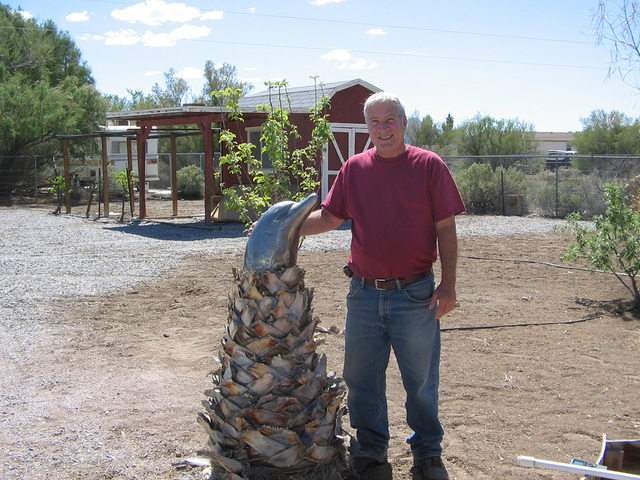
Growing up as a teen during the 1960s and 1970s in Los Angeles, sculptor Peter David Pete Ehrlich said people were either a surfer or a car geek.
He was the latter, after getting beat up by a surfboard.
Ive been working with my hands all my life, Ehrlich said.
The love of tinkering around with cars and auto bodies was a precursor in putting his hands to work as a sculptor.
Ehrlich said he became car struck when he was a kid while driving by an auto body shop with his father. When he got older, he did custom auto body work, which later helped his sculptures.
I mastered all those techniques and tools doing auto body work, so when it came to working on stone, it was almost second nature, he said. Now, instead of reproducing somebody elses design, I had to come up with my own. But like sculpting a curve, that was something that came very easy to me from doing all the car work.
Working on fenders, you have to be able to deal with curves.
After working on cars for nearly 10 years, Ehrlich decided to go back to school and wanted to study electrical engineering. However, he found the math too difficult, due to lingering effects from two bouts of encephalitis when he was ages 5 and 17.
He took courses in sculpting, drawing and designing to complete his associate degree in liberal arts from Santa Monica College and launched his career as a master sculptor.
Most of his sculptures center around animals and figures related to marine life. Ehrlich said he visited Marineland as a child and fell in love with a pilot whale. But what really hooked him was the 1960s Flipper television show featuring a dolphin.
One exception is a horse head named Equus. This was his fourth sculpture, as he went to work on a flawed Mexican alabaster stone that another artist no longer wanted.
He said dolphins are pretty easy to carve, kind of banana-shaped with a couple of wedges. The horse is one of his finest pieces and he left the studio not even knowing how he did it.
Well really, where I cut my teeth doing sculpture was doing auto body work and so I was used to making things, he said. But taking that piece of stone and carving a horse out of it made me take a step back and I didnt really know if I could ever do anything like this again. I thought it was, you know, a fluke.
He also created a sculpture of a mermaid, Paula, out of a five-ton alabaster rock from St. George, Utah in his former Culver City, California studio. When finished, she was scaled down to two tons and six and a half feet long.
I gotta tell you, cutting off all that weight.., Ehrlich said.
Alabaster or gypsum is his favorite stone of choice. From working with it over the years, he discovered that the dust, which he calls magic dust, has healing properties in treating cuts, scrapes and bruises.
In the late 1980s, he went to Sea World in San Diego to create a model of a dolphin.
Yeah, I just brought a big lump of clay and started pushing it around, he said.
Aside from visitors watching him, Ehrlich said one of the dolphins in the aquariums even watched as he crafted the clay. From this model Ehrlich made a mold and other dolphins surfaced from it, later being cast in bronze, stainless steel and glass.
People in Santa Monica can still view Ehrlichs work. Three of his dolphin sculptures, or piggy banks, have been displayed and appreciated since 1993 on the boardwalk at the Santa Monica pier, on Main Street and on the Third Street Promenade as part of the Dolphin Change Program to help the homeless. Residents and visitors can drop money into the sculpted sea animals to help fund the citys social service organizations aiding the homeless.
Ehrlich is now retired and no longer able to carve his beloved sculptures due to health issues from the long-term effects of encephalitis when he was young. The filing, chiseling, carving and pounding on stone for hours is physically demanding and stressful.
He said it is a function of his personality to be always working on something.
My mind likes to create; it doesnt have to be doing this.
Ehrlich compared his past in carving sculptures to Oliver Stones biography of Michelangelo, The Agony and the Ecstasy.
It couldnt be a more perfect title because its exactly what it was doing this work, it was agony and it was ecstasy.
He has included his sculptures and the stories behind them in a book, Sculpture Stories, which will be available by September on Kindle through Amazon.com.
Ehrlich has another Kindle edition book titled The Day the Dolphin Died which is also available through Amazon.com.